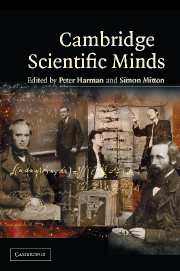Book contents
- Frontmatter
- Contents
- Foreword
- Introduction
- 1 William Gilbert
- 2 William Harvey
- 3 Isaac Newton: Creator of the Cambridge scientific tradition
- 4 William Whewell: A Cambridge historian and philosopher of science
- 5 Adam Sedgwick: A confident mind in turmoil
- 6 Charles Babbage: Science and reform
- 7 Charles Darwin
- 8 Stokes and Kelvin, Cambridge and Glasgow, light and heat
- 9 James Clerk Maxwell
- 10 The duo from Trinity: A.N. Whitehead and Bertrand Russell on the foundations of mathematics, 1895–1925
- 11 Thomson, Rutherford and atomic physics at the Cavendish
- 12 Hopkins and biochemistry
- 13 Charles Sherrington, E.D. Adrian, and Henry Dale: The Cambridge Physiological Laboratory and the physiology of the nervous system
- 14 Hardy and Littlewood
- 15 Arthur Stanley Eddington
- 16 Paul Dirac: A quantum genius
- 17 Alan Turing
- 18 Francis Crick and James Watson
- 19 Mary Cartwright
- 20 Joseph Needham
- 21 Molecular biology in Cambridge
- 22 The discovery of pulsars – prelude and aftermath
- 23 Stephen W. Hawking
Introduction
Published online by Cambridge University Press: 05 June 2014
- Frontmatter
- Contents
- Foreword
- Introduction
- 1 William Gilbert
- 2 William Harvey
- 3 Isaac Newton: Creator of the Cambridge scientific tradition
- 4 William Whewell: A Cambridge historian and philosopher of science
- 5 Adam Sedgwick: A confident mind in turmoil
- 6 Charles Babbage: Science and reform
- 7 Charles Darwin
- 8 Stokes and Kelvin, Cambridge and Glasgow, light and heat
- 9 James Clerk Maxwell
- 10 The duo from Trinity: A.N. Whitehead and Bertrand Russell on the foundations of mathematics, 1895–1925
- 11 Thomson, Rutherford and atomic physics at the Cavendish
- 12 Hopkins and biochemistry
- 13 Charles Sherrington, E.D. Adrian, and Henry Dale: The Cambridge Physiological Laboratory and the physiology of the nervous system
- 14 Hardy and Littlewood
- 15 Arthur Stanley Eddington
- 16 Paul Dirac: A quantum genius
- 17 Alan Turing
- 18 Francis Crick and James Watson
- 19 Mary Cartwright
- 20 Joseph Needham
- 21 Molecular biology in Cambridge
- 22 The discovery of pulsars – prelude and aftermath
- 23 Stephen W. Hawking
Summary
The University of Cambridge can point to a long roster of distinguished scientists and mathematicians who have been associated with its history over the past 400 years, since the ‘scientific revolution’ of the seventeenth century. Their names include three of the greatest luminaries in the entire history of science: Isaac Newton, Charles Darwin, and James Clerk Maxwell. The link between the Cambridge present and the magnitude of past achievement is highlighted by the names given to institutions and buildings in the University: Darwin College, the Newton Institute, Harvey Court. This sense of continuity, that the work of the present age is linked to the traditions of the founding fathers, has prompted this collection of essays on Cambridge scientists, intended to interest a broad non-specialist readership within and beyond the University. But to the historian such associations, though beguiling, are problematic, suggesting sentiment or constructed ‘heritage’ rather than historical reality. Can figures of the early modern period – Isaac Newton, William Gilbert, William Harvey – be properly described as ‘scientists’? The term, with its resonances of professional specialisation, was only introduced (by another Cambridge notable, William Whewell) in 1834. Does Cambridge ‘science’ have a 400-year history, or is it a product of the professionalisation of science, of teaching and research, since 1850 and especially since 1900? Is there indeed a specifically Cantabrigian scientific culture? The three major scientific figures associated with the University illustrate some of the problems in defining Cambridge science.
- Type
- Chapter
- Information
- Cambridge Scientific Minds , pp. 1 - 5Publisher: Cambridge University PressPrint publication year: 2002



